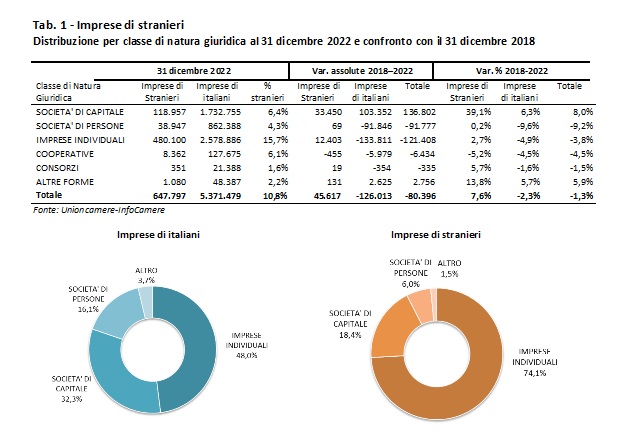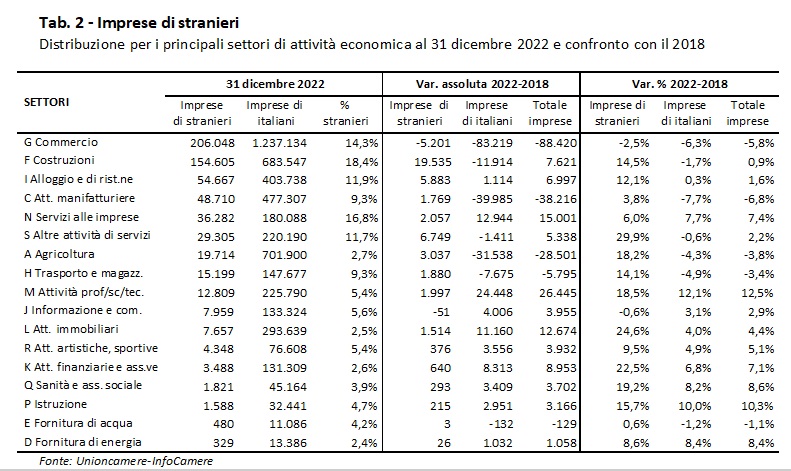How many foreign companies are there in Italy? Unioncamere-InfoCamere report

In the last five years, foreign entrepreneurship has recorded a cumulative growth of 7.6% against a decrease of 2.3% in Italian companies. Numbers, trends and scenarios taken from an updated report by Unioncamere-InfoCamere
Entrepreneurship of foreign origins has long been a structural datum of our production system. At the end of 2022, companies with a prevalence of partners and/or directors born outside the national borders were close to 650 thousand units, just over 10% of the entire business base of the country (just over 6 million units).
This is what emerges from the data of the Business Register of the Chambers of Commerce referring to the period 2018-2022 processed by Unioncamere-InfoCamere on the basis of Movimprese , the statistical analysis on the demographic trend of Italian companies.
Here are all the details, with tables and graphs.

This stable presence is accompanied by a personal dynamism unknown to businesses started by people born in Italy. In the last five years, foreign entrepreneurship has recorded a cumulative growth of 7.6% against a decrease of 2.3% in Italian companies. In absolute terms, these dynamics cannot compensate for the disappearance of Italian businesses: from 2018 to today, foreign businesses have increased by 45,617 units while non-foreign ones have decreased by 126,013 units, so that the overall total of the country's entrepreneurial base is reduced by 80,396 businesses.
THE DIFFERENCES
There are still profound structural differences between the two universes (foreigners' businesses and Italians' businesses). Among the former, the report reads, the largely prevailing form is still that of the sole proprietorship (74.1%) where for the activities of Italians this share has for some years now fallen steadily below the 50% threshold. Net of the stop imposed by the pandemic, the trend of the last five years shows a very strong substitution effect between new immigrant entrepreneurship and the Italian presence in this which is the simplest form of business.

The second organizational method preferred by companies is that of the joint-stock company. Although their presence is decidedly more numerous among Italian initiatives (where they exceed the 32% share) than among those of foreigners (where it stops at 18.4%), in the case of the latter, the five years behind us signal a more than marked vitality of this form of enterprise among those of immigrant origin (+39.1% against +6.3% of the activities of Italians in the period considered).
THE SECTORS IN WHICH THEY OPERATE
The sectoral comparison between the paths of businesses of foreigners and our compatriots in the last five years highlights differences – even significant ones – between what happens at the level of the individual production sectors. In some cases, the expansion of the entrepreneurial base of foreign origins contrasts an opposite trend of Italian companies, managing not only to compensate for the losses of the latter but – in some cases – also to grow the entire segment: as happens in construction (where Italian companies lose almost 12 thousand units and foreign ones increase by over 19 thousand) or in other service activities (in which Italian companies decrease by 1,411 units while foreign ones grow by almost 6,800).
In other cases, companies owned by foreigners follow the trend of companies owned by Italians, however, recording – for better or for worse – almost always better performances. Where foreign and native grow, the former always do better than the latter, with the only exceptions of business services and energy supply. On the other hand, when the entrepreneurial base shrinks, foreign companies show a much more marked resilience: as in trade, where the reduction of Italian companies is -6.3%, that of foreign companies is -2.5%.
In other cases the "mirror" scheme is configured (with foreign women increasing while those of Italians decrease) in which, however, the dynamics of foreign women is not sufficient to compensate for the contraction of the others. This is the case for agriculture, which in the five-year period lost a total of 28,501 companies and saw foreign companies grow by only 3,037 units (with variations of -4.3% for Italians and +18.2% for foreigners). And it is the same for manufacturing activities, where Italian companies lose 39,985 units and foreign companies recover just 1,769 (-7.7% against +3.8% in favor of foreign companies).
This is a machine translation from Italian language of a post published on Start Magazine at the URL https://www.startmag.it/economia/quante-sono-le-imprese-di-stranieri-in-italia-report-unioncamere-infocamere/ on Mon, 13 Mar 2023 11:29:28 +0000.
